what is a car’s acceleration if it increases its speed from 5 m/s to 20 m/s in 3 s?
Learning Objectives
By the end of this section, you lot will be able to:
- Identify which equations of motility are to be used to solve for unknowns.
- Employ appropriate equations of motion to solve a ii-body pursuit trouble.
Y'all might guess that the greater the dispatch of, say, a car moving abroad from a terminate sign, the greater the car's deportation in a given fourth dimension. But, we have not adult a specific equation that relates dispatch and displacement. In this section, we look at some convenient equations for kinematic relationships, starting from the definitions of displacement, velocity, and acceleration. Nosotros beginning investigate a single object in motion, chosen single-body motion. So we investigate the motion of two objects, chosen ii-body pursuit issues.
Notation
Start, permit us make some simplifications in notation. Taking the initial time to be nothing, as if time is measured with a stopwatch, is a great simplification. Since elapsed time is [latex] \text{Δ}t={t}_{\text{f}}-{t}_{0} [/latex], taking [latex] {t}_{0}=0 [/latex] means that[latex] \text{Δ}t={t}_{\text{f}} [/latex], the last time on the stopwatch. When initial time is taken to be zero, we utilise the subscript 0 to denote initial values of position and velocity. That is, [latex] {ten}_{0} [/latex] is the initial position and [latex] {v}_{0} [/latex] is the initial velocity. We put no subscripts on the final values. That is, t is the final time, x is the final position, and v is the concluding velocity. This gives a simpler expression for elapsed time, [latex] \text{Δ}t=t [/latex]. It also simplifies the expression for ten displacement, which is now [latex] \text{Δ}x=10-{ten}_{0} [/latex]. Also, it simplifies the expression for change in velocity, which is now [latex] \text{Δ}v=v-{5}_{0} [/latex]. To summarize, using the simplified note, with the initial time taken to exist goose egg,
[latex] \begin{array}{c}\text{Δ}t=t\hfill \\ \text{Δ}x=x-{x}_{0}\hfill \\ \text{Δ}v=v-{v}_{0},\hfill \terminate{array} [/latex]
where the subscript 0 denotes an initial value and the absence of a subscript denotes a final value in any motion is under consideration.
We at present make the of import assumption that dispatch is abiding. This supposition allows u.s.a. to avert using calculus to detect instantaneous dispatch. Since acceleration is constant, the average and instantaneous accelerations are equal—that is,
[latex] \overset{\text{–}}{a}=a=\text{constant}\text{.} [/latex]
Thus, nosotros can use the symbol a for acceleration at all times. Assuming acceleration to be abiding does non seriously limit the situations we can study nor does it degrade the accuracy of our treatment. For one thing, dispatch is constant in a keen number of situations. Furthermore, in many other situations we can describe motion accurately by bold a constant acceleration equal to the average acceleration for that movement. Lastly, for motion during which dispatch changes drastically, such as a car accelerating to top speed then braking to a stop, motility can be considered in carve up parts, each of which has its own constant dispatch.
Deportation and Position from Velocity
To get our get-go two equations, nosotros start with the definition of average velocity:
[latex] \overset{\text{–}}{v}=\frac{\text{Δ}10}{\text{Δ}t}. [/latex]
Substituting the simplified notation for [latex] \text{Δ}x [/latex] and [latex] \text{Δ}t [/latex] yields
[latex] \overset{\text{–}}{v}=\frac{x-{x}_{0}}{t}. [/latex]
Solving for x gives us
[latex] x={10}_{0}+\overset{\text{–}}{v}t, [/latex]
where the average velocity is
[latex] \overset{\text{–}}{v}=\frac{{five}_{0}+5}{two}. [/latex]
The equation [latex] \overset{\text{–}}{v}=\frac{{v}_{0}+v}{2} [/latex] reflects the fact that when acceleration is constant, v is but the simple average of the initial and final velocities. (Figure) illustrates this concept graphically. In part (a) of the effigy, acceleration is constant, with velocity increasing at a constant charge per unit. The average velocity during the 1-h interval from 40 km/h to 80 km/h is 60 km/h:
[latex] \overset{\text{–}}{five}=\frac{{v}_{0}+v}{2}=\frac{40\,\text{km/h}+80\,\text{km/h}}{2}=60\,\text{km/h}\text{.} [/latex]
In role (b), acceleration is not constant. During the one-h interval, velocity is closer to 80 km/h than 40 km/h. Thus, the boilerplate velocity is greater than in office (a).
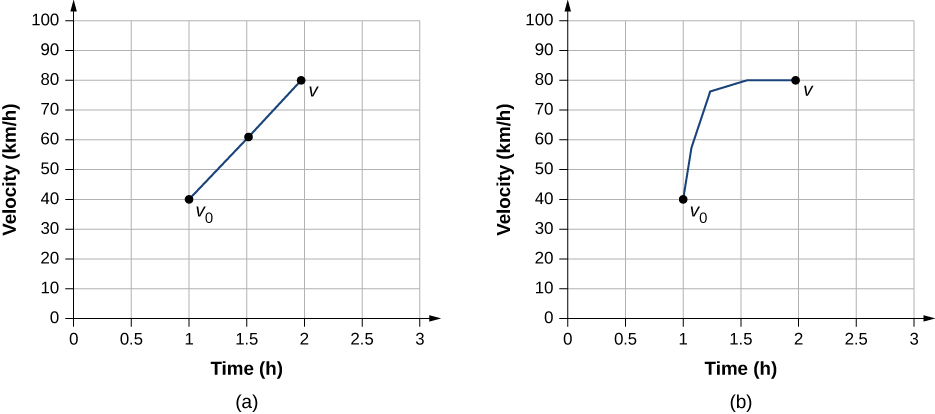
Effigy three.18 (a) Velocity-versus-time graph with constant dispatch showing the initial and concluding velocities [latex] {5}_{0}\,\text{and}\,v [/latex]. The average velocity is [latex] \frac{1}{2}({5}_{0}+v)=lx\,\text{km}\text{/}\text{h} [/latex]. (b) Velocity-versus-time graph with an acceleration that changes with fourth dimension. The average velocity is not given by [latex] \frac{1}{2}({five}_{0}+5) [/latex], but is greater than 60 km/h.
Solving for Terminal Velocity from Acceleration and Time
We can derive some other useful equation by manipulating the definition of acceleration:
[latex] a=\frac{\text{Δ}5}{\text{Δ}t}. [/latex]
Substituting the simplified notation for [latex] \text{Δ}v [/latex] and [latex] \text{Δ}t [/latex] gives us
[latex] a=\frac{v-{five}_{0}}{t}\enspace(\text{abiding}\,a). [/latex]
Solving for v yields
[latex] 5={5}_{0}+at\enspace(\text{abiding}\,a). [/latex]
Case
Computing Terminal Velocity
An airplane lands with an initial velocity of 70.0 k/s and then decelerates at one.50 chiliad/stwo for 40.0 s. What is its concluding velocity?
Strategy
Kickoff, we identify the knowns: [latex] {five}_{0}=70\,\text{m/due south,}\,a=-one.50{\,\text{m/s}}^{2},t=xl\,\text{south} [/latex].
Second, we identify the unknown; in this case, it is terminal velocity [latex] {five}_{\text{f}} [/latex].
Last, we determine which equation to employ. To exercise this nosotros figure out which kinematic equation gives the unknown in terms of the knowns. We summate the final velocity using (Figure), [latex] v={5}_{0}+at [/latex].
Solution

Figure 3.19 The aeroplane lands with an initial velocity of 70.0 thousand/s and slows to a final velocity of x.0 thousand/s earlier heading for the terminal. Annotation the acceleration is negative considering its direction is opposite to its velocity, which is positive.
Significance
The concluding velocity is much less than the initial velocity, every bit desired when slowing downward, simply is all the same positive (encounter figure). With jet engines, reverse thrust can exist maintained long plenty to end the airplane and start moving it backward, which is indicated past a negative concluding velocity, but is non the case here.
In improver to beingness useful in trouble solving, the equation [latex] 5={5}_{0}+at [/latex] gives us insight into the relationships among velocity, acceleration, and fourth dimension. We can see, for case, that
- Final velocity depends on how large the acceleration is and how long it lasts
- If the acceleration is goose egg, then the terminal velocity equals the initial velocity (5 = v 0), equally expected (in other words, velocity is constant)
- If a is negative, then the concluding velocity is less than the initial velocity
All these observations fit our intuition. Note that it is always useful to examine basic equations in light of our intuition and experience to bank check that they do indeed describe nature accurately.
Solving for Final Position with Constant Dispatch
We can combine the previous equations to find a third equation that allows us to summate the final position of an object experiencing constant dispatch. We start with
[latex] v={v}_{0}+at. [/latex]
Calculation [latex] {v}_{0} [/latex] to each side of this equation and dividing by two gives
[latex] \frac{{v}_{0}+5}{2}={5}_{0}+\frac{one}{ii}at. [/latex]
Since [latex] \frac{{v}_{0}+v}{two}=\overset{\text{–}}{5} [/latex] for constant dispatch, we have
[latex] \overset{\text{–}}{v}={v}_{0}+\frac{one}{2}at. [/latex]
Now we substitute this expression for [latex] \overset{\text{–}}{v} [/latex] into the equation for displacement, [latex] x={x}_{0}+\overset{\text{–}}{v}t [/latex], yielding
[latex] x={x}_{0}+{v}_{0}t+\frac{1}{2}a{t}^{ii}\enspace(\text{constant}\,a). [/latex]
Case
Calculating Displacement of an Accelerating Object
Dragsters can attain an average acceleration of 26.0 m/south2. Suppose a dragster accelerates from residual at this rate for five.56 s (Effigy). How far does information technology travel in this fourth dimension?
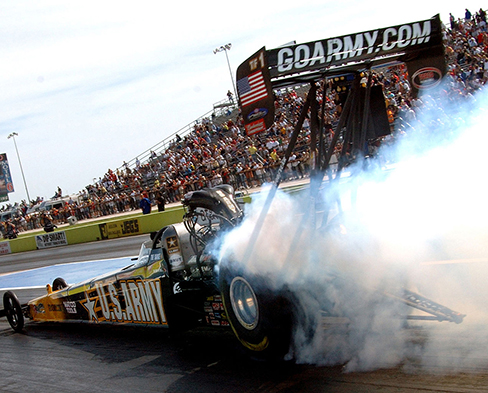
Figure 3.twenty U.Due south. Ground forces Top Fuel pilot Tony "The Sarge" Schumacher begins a race with a controlled burnout. (credit: Lt. Col. William Thurmond. Photo Courtesy of U.S. Army.)
Strategy
First, allow's draw a sketch (Figure). We are asked to find displacement, which is x if we accept [latex] {x}_{0} [/latex] to exist null. (Recall well-nigh [latex] {x}_{0} [/latex] as the starting line of a race. It tin can be anywhere, but we call it nil and mensurate all other positions relative to it.) We can apply the equation [latex] x={x}_{0}+{v}_{0}t+\frac{1}{ii}a{t}^{2} [/latex] when we identify [latex] {five}_{0} [/latex], [latex] a [/latex], and t from the statement of the trouble.

Figure 3.21 Sketch of an accelerating dragster.
Solution
Significance
If we catechumen 402 yard to miles, we detect that the distance covered is very close to i-quarter of a mile, the standard altitude for elevate racing. So, our reply is reasonable. This is an impressive displacement to cover in only 5.56 s, simply top-notch dragsters can do a quarter mile in even less time than this. If the dragster were given an initial velocity, this would add another term to the distance equation. If the same acceleration and time are used in the equation, the altitude covered would be much greater.
What else tin we learn by examining the equation [latex] x={x}_{0}+{v}_{0}t+\frac{one}{2}a{t}^{2}? [/latex] We can encounter the following relationships:
- Displacement depends on the square of the elapsed time when acceleration is not zero. In (Figure), the dragster covers only one-fourth of the full distance in the first half of the elapsed fourth dimension.
- If acceleration is cipher, then initial velocity equals boilerplate velocity [latex] ({v}_{0}=\overset{\text{–}}{v}) [/latex], and [latex] 10={10}_{0}+{v}_{0}t+\frac{1}{ii}\,a{t}^{ii}\,\text{becomes}\,x={x}_{0}+{v}_{0}t. [/latex]
Solving for Final Velocity from Distance and Dispatch
A 4th useful equation can be obtained from another algebraic manipulation of previous equations. If we solve [latex] five={v}_{0}+at [/latex] for t, we become
[latex] t=\frac{five-{v}_{0}}{a}. [/latex]
Substituting this and [latex] \overset{\text{–}}{v}=\frac{{v}_{0}+v}{ii} [/latex] into [latex] x={x}_{0}+\overset{\text{–}}{5}t [/latex], we get
[latex] {v}^{2}={five}_{0}^{ii}+2a(x-{x}_{0})\enspace(\text{constant}\,a). [/latex]
Example
Calculating Terminal Velocity
Summate the final velocity of the dragster in (Figure) without using information about time.
Strategy
The equation [latex] {v}^{ii}={v}_{0}^{ii}+2a(x-{x}_{0}) [/latex] is ideally suited to this chore because it relates velocities, acceleration, and displacement, and no time information is required.
Solution
Significance
A velocity of 145 1000/s is virtually 522 km/h, or about 324 mi/h, but even this breakneck speed is brusk of the record for the quarter mile. Also, notation that a square root has two values; we took the positive value to indicate a velocity in the aforementioned management equally the acceleration.
An examination of the equation [latex] {five}^{2}={v}_{0}^{two}+2a(10-{x}_{0}) [/latex] can produce additional insights into the general relationships amidst concrete quantities:
- The last velocity depends on how large the acceleration is and the altitude over which information technology acts.
- For a fixed dispatch, a car that is going twice as fast doesn't only stop in twice the distance. Information technology takes much farther to stop. (This is why nosotros accept reduced speed zones near schools.)
Putting Equations Together
In the post-obit examples, we continue to explore one-dimensional motion, but in situations requiring slightly more algebraic manipulation. The examples also requite insight into problem-solving techniques. The note that follows is provided for easy reference to the equations needed. Be aware that these equations are not independent. In many situations we have two unknowns and demand two equations from the set to solve for the unknowns. We need every bit many equations every bit in that location are unknowns to solve a given situation.
Summary of Kinematic Equations (constant a)
[latex] ten={x}_{0}+\overset{\text{–}}{v}t [/latex]
[latex] \overset{\text{–}}{v}=\frac{{five}_{0}+five}{two} [/latex]
[latex] v={v}_{0}+at [/latex]
[latex] ten={x}_{0}+{v}_{0}t+\frac{1}{2}a{t}^{2} [/latex]
[latex] {v}^{2}={5}_{0}^{2}+2a(x-{ten}_{0}) [/latex]
Before nosotros go into the examples, let's wait at some of the equations more closely to encounter the beliefs of acceleration at farthermost values. Rearranging (Figure), we have
[latex] a=\frac{v-{v}_{0}}{t}. [/latex]
From this we run into that, for a finite time, if the difference between the initial and final velocities is small, the acceleration is modest, approaching zero in the limit that the initial and final velocities are equal. On the contrary, in the limit [latex] t\to 0 [/latex] for a finite difference between the initial and final velocities, acceleration becomes space.
Similarly, rearranging (Figure), nosotros can express dispatch in terms of velocities and deportation:
[latex] a=\frac{{five}^{two}-{five}_{0}^{2}}{ii(x-{x}_{0})}. [/latex]
Thus, for a finite difference between the initial and final velocities acceleration becomes infinite in the limit the displacement approaches zero. Acceleration approaches zero in the limit the difference in initial and concluding velocities approaches goose egg for a finite displacement.
Example
How Far Does a Car Get?
On dry concrete, a car tin can decelerate at a rate of vii.00 m/south2, whereas on wet concrete it can decelerate at but 5.00 m/s2. Find the distances necessary to stop a car moving at thirty.0 m/s (about 110 km/h) on (a) dry out concrete and (b) moisture concrete. (c) Echo both calculations and find the displacement from the point where the driver sees a traffic light turn red, taking into account his reaction time of 0.500 s to get his foot on the restriction.
Strategy
Showtime, we need to describe a sketch (Figure). To determine which equations are best to use, nosotros demand to list all the known values and identify exactly what we need to solve for.
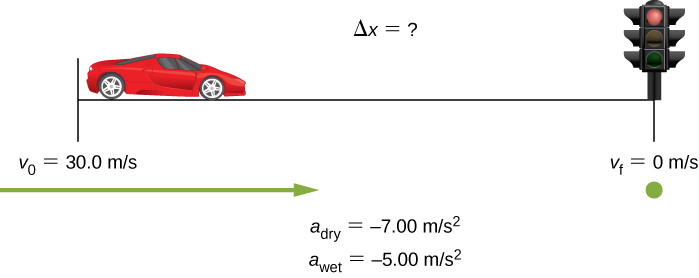
Effigy iii.22 Sample sketch to visualize deceleration and stopping altitude of a car.
Solution
- First, we demand to identify the knowns and what we want to solve for. Nosotros know that five 0 = 30.0 g/southward, five = 0, and a = −7.00 m/southtwo (a is negative because it is in a direction reverse to velocity). We take x 0 to be nada. We are looking for displacement [latex] \text{Δ}10 [/latex], or x − ten 0.Second, we place the equation that will aid us solve the trouble. The all-time equation to use is
[latex] {5}^{two}={five}_{0}^{2}+2a(ten-{x}_{0}). [/latex]
This equation is best considering information technology includes only one unknown, x. We know the values of all the other variables in this equation. (Other equations would allow us to solve for x, but they require us to know the stopping fourth dimension, t, which nosotros practise non know. We could use them, just it would entail boosted calculations.)
Third, we rearrange the equation to solve for x:
[latex] x-{ten}_{0}=\frac{{five}^{2}-{five}_{0}^{ii}}{2a} [/latex]
and substitute the known values:
[latex] ten-0=\frac{{0}^{ii}-{(30.0\,\text{g/s})}^{ii}}{two(-vii.00{\text{m/s}}^{2})}. [/latex]
Thus,
[latex] x=64.iii\,\text{m on dry concrete}\text{.} [/latex]
- This part tin be solved in exactly the same manner as (a). The only difference is that the acceleration is −five.00 m/s2. The result is
[latex] {x}_{\text{moisture}}=90.0\,\text{m on moisture concrete.} [/latex]
-
Evidence Reply
When the driver reacts, the stopping distance is the same equally it is in (a) and (b) for dry and wet concrete. So, to answer this question, we need to calculate how far the motorcar travels during the reaction time, and and so add that to the stopping time. Information technology is reasonable to assume the velocity remains constant during the driver'southward reaction fourth dimension.To do this, nosotros, again, identify the knowns and what we want to solve for. We know that [latex] \overset{\text{–}}{v}=30.0\,\text{m/due south} [/latex], [latex] {t}_{\text{reaction}}=0.500\,\text{s} [/latex], and [latex] {a}_{\text{reaction}}=0 [/latex]. Nosotros take [latex] {x}_{\text{0-reaction}} [/latex] to be nothing. We are looking for [latex] {10}_{\text{reaction}} [/latex].Second, as earlier, we identify the best equation to use. In this case, [latex] 10={x}_{0}+\overset{\text{–}}{five}t [/latex] works well considering the simply unknown value is 10, which is what we want to solve for.Tertiary, nosotros substitute the knowns to solve the equation: [latex] 10=0+(thirty.0\,\text{m/s})(0.500\,\text{s})=15.0\,\text{thou}. [/latex] This means the machine travels 15.0 k while the driver reacts, making the total displacements in the 2 cases of dry and moisture concrete 15.0 m greater than if he reacted instantly. Terminal, nosotros then add the displacement during the reaction time to the displacement when braking ((Effigy)), [latex] {x}_{\text{braking}}+{x}_{\text{reaction}}={x}_{\text{full}}, [/latex] and find (a) to exist 64.three thou + 15.0 m = 79.3 m when dry and (b) to be xc.0 m + fifteen.0 chiliad = 105 m when moisture.
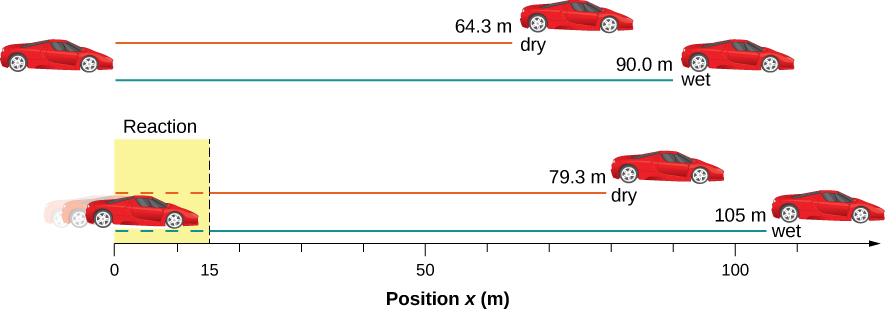
Figure 3.23 The distance necessary to stop a motorcar varies greatly, depending on road conditions and commuter reaction time. Shown hither are the braking distances for dry and moisture pavement, as calculated in this instance, for a car traveling initially at 30.0 thou/s. Also shown are the total distances traveled from the signal when the driver first sees a low-cal turn crimson, assuming a 0.500-s reaction time.
Significance
The displacements found in this example seem reasonable for stopping a fast-moving automobile. It should take longer to stop a car on wet pavement than dry. It is interesting that reaction time adds significantly to the displacements, only more than important is the full general arroyo to solving problems. We identify the knowns and the quantities to be determined, then find an advisable equation. If at that place is more than than i unknown, we need as many independent equations as there are unknowns to solve. There is oft more than one way to solve a problem. The diverse parts of this example tin, in fact, be solved past other methods, merely the solutions presented here are the shortest.
Example
Computing Time
Suppose a automobile merges into freeway traffic on a 200-m-long ramp. If its initial velocity is 10.0 m/due south and it accelerates at 2.00 m/due south2, how long does it take the car to travel the 200 thou up the ramp? (Such information might be useful to a traffic engineer.)
Strategy
Start, nosotros describe a sketch (Figure). Nosotros are asked to solve for time t. Every bit earlier, we identify the known quantities to cull a convenient concrete human relationship (that is, an equation with one unknown, t.)
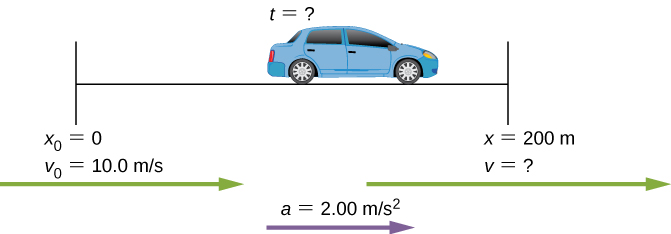
Effigy iii.24 Sketch of a machine accelerating on a pike ramp.
Solution
Significance
Whenever an equation contains an unknown squared, there are 2 solutions. In some problems both solutions are meaningful; in others, just one solution is reasonable. The 10.0-s answer seems reasonable for a typical state highway on-ramp.
Bank check Your Understanding
A manned rocket accelerates at a rate of 20 yard/due south2 during launch. How long does it take the rocket to reach a velocity of 400 one thousand/s?
Example
Acceleration of a Spaceship
A spaceship has left Earth's orbit and is on its way to the Moon. It accelerates at 20 m/s2 for ii min and covers a distance of 1000 km. What are the initial and final velocities of the spaceship?
Strategy
We are asked to find the initial and final velocities of the spaceship. Looking at the kinematic equations, nosotros meet that one equation will non give the answer. Nosotros must employ ane kinematic equation to solve for one of the velocities and substitute it into some other kinematic equation to get the 2d velocity. Thus, nosotros solve two of the kinematic equations simultaneously.
Solution
Significance
There are six variables in displacement, time, velocity, and acceleration that describe motion in one dimension. The initial weather condition of a given problem can be many combinations of these variables. Because of this diversity, solutions may not exist like shooting fish in a barrel as uncomplicated substitutions into one of the equations. This example illustrates that solutions to kinematics may require solving ii simultaneous kinematic equations.
With the basics of kinematics established, we can get on to many other interesting examples and applications. In the process of developing kinematics, nosotros have also glimpsed a general arroyo to problem solving that produces both correct answers and insights into physical relationships. The next level of complication in our kinematics issues involves the motion of 2 interrelated bodies, called two-body pursuit issues.
Two-Body Pursuit Problems
Up until this point nosotros have looked at examples of move involving a single body. Even for the problem with two cars and the stopping distances on moisture and dry roads, we divided this problem into 2 separate bug to observe the answers. In a two-body pursuit trouble, the motions of the objects are coupled—meaning, the unknown we seek depends on the motion of both objects. To solve these issues we write the equations of movement for each object and then solve them simultaneously to observe the unknown. This is illustrated in (Figure).

Figure 3.25 A two-torso pursuit scenario where car ii has a constant velocity and car one is behind with a constant dispatch. Car 1 catches upwards with car 2 at a after time.
The fourth dimension and distance required for car one to catch car 2 depends on the initial distance car 1 is from motorcar 2 as well every bit the velocities of both cars and the acceleration of machine 1. The kinematic equations describing the motion of both cars must be solved to notice these unknowns.
Consider the following example.
Example
Cheetah Communicable a Gazelle
A cheetah waits in hiding backside a bush-league. The cheetah spots a gazelle running past at x m/s. At the instant the gazelle passes the chetah, the cheetah accelerates from rest at four m/stwo to take hold of the gazelle. (a) How long does information technology have the cheetah to catch the gazelle? (b) What is the displacement of the gazelle and cheetah?
Strategy
We use the set of equations for constant acceleration to solve this problem. Since in that location are two objects in move, we have separate equations of motion describing each animal. But what links the equations is a common parameter that has the same value for each fauna. If we look at the trouble closely, it is clear the mutual parameter to each animal is their position x at a afterward time t. Since they both start at [latex] {x}_{0}=0 [/latex], their displacements are the same at a later fourth dimension t, when the cheetah catches up with the gazelle. If we option the equation of motion that solves for the displacement for each animal, we tin can then set the equations equal to each other and solve for the unknown, which is time.
Solution
-
Show Reply
Equation for the gazelle: The gazelle has a constant velocity, which is its average velocity, since information technology is not accelerating. Therefore, we use (Figure) with [latex] {ten}_{0}=0 [/latex]: [latex] x={x}_{0}+\overset{\text{–}}{v}t=\overset{\text{–}}{v}t. [/latex] Equation for the cheetah: The cheetah is accelerating from balance, then we utilize (Figure) with [latex] {x}_{0}=0 [/latex] and [latex] {v}_{0}=0 [/latex]: [latex] ten={x}_{0}+{v}_{0}t+\frac{one}{2}a{t}^{2}=\frac{ane}{2}a{t}^{2}. [/latex] At present we take an equation of motion for each animal with a common parameter, which can exist eliminated to find the solution. In this case, we solve for t: [latex] \brainstorm{array}{cc} x=\overset{\text{–}}{v}t=\frac{1}{ii}a{t}^{ii}\hfill \\ t=\frac{ii\overset{\text{–}}{v}}{a}.\hfill \end{array} [/latex] The gazelle has a constant velocity of ten thou/due south, which is its average velocity. The acceleration of the cheetah is iv m/s2. Evaluating t, the time for the cheetah to reach the gazelle, we have [latex] t=\frac{2\overset{\text{–}}{v}}{a}=\frac{two(x)}{4}=five\,\text{s}\text{.} [/latex]
-
Show Reply
To go the deportation, we use either the equation of motion for the cheetah or the gazelle, since they should both give the same reply.Displacement of the chetah: [latex] 10=\frac{1}{2}a{t}^{ii}=\frac{1}{ii}(4){(5)}^{two}=50\,\text{m}\text{.} [/latex] Deportation of the gazelle: [latex] x=\overset{\text{–}}{v}t=10(five)=50\,\text{k}\text{.} [/latex] Nosotros see that both displacements are equal, as expected.
Significance
It is of import to analyze the move of each object and to utilise the appropriate kinematic equations to describe the individual motility. It is likewise of import to have a good visual perspective of the two-body pursuit problem to see the common parameter that links the move of both objects.
Check Your Understanding
A wheel has a constant velocity of x m/s. A person starts from rest and runs to take hold of up to the bike in 30 southward. What is the acceleration of the person?
Show Solution
[latex] a=\frac{2}{3}{\,\text{m/southward}}^{2} [/latex].
Summary
- When analyzing 1-dimensional motion with abiding acceleration, identify the known quantities and choose the appropriate equations to solve for the unknowns. Either one or two of the kinematic equations are needed to solve for the unknowns, depending on the known and unknown quantities.
- Ii-body pursuit problems always require two equations to be solved simultaneously for the unknowns.
Conceptual Questions
When analyzing the motion of a single object, what is the required number of known physical variables that are needed to solve for the unknown quantities using the kinematic equations?
State two scenarios of the kinematics of single object where iii known quantities crave ii kinematic equations to solve for the unknowns.
Show Solution
If the dispatch, time, and displacement are the knowns, and the initial and final velocities are the unknowns, then two kinematic equations must be solved simultaneously. Also if the concluding velocity, fourth dimension, and displacement are the knowns so two kinematic equations must exist solved for the initial velocity and dispatch.
Problems
A particle moves in a directly line at a constant velocity of 30 m/s. What is its displacement between t = 0 and t = 5.0 s?
A particle moves in a straight line with an initial velocity of 30 1000/southward and a constant acceleration of 30 k/due southtwo. If at [latex] t=0,x=0 [/latex] and [latex] five=0 [/latex], what is the particle's position at t = 5 s?
A particle moves in a straight line with an initial velocity of 30 one thousand/s and constant acceleration 30 m/s2. (a) What is its deportation at t = 5 s? (b) What is its velocity at this same fourth dimension?
(a) Sketch a graph of velocity versus time respective to the graph of displacement versus time given in the post-obit figure. (b) Identify the time or times (t a, t b, t c, etc.) at which the instantaneous velocity has the greatest positive value. (c) At which times is it nothing? (d) At which times is it negative?
Testify Answer
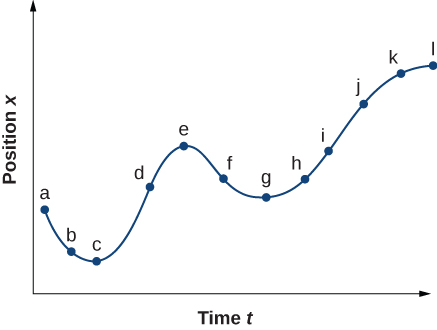
(a) Sketch a graph of acceleration versus time corresponding to the graph of velocity versus time given in the following figure. (b) Identify the fourth dimension or times (t a, t b, t c, etc.) at which the dispatch has the greatest positive value. (c) At which times is it zero? (d) At which times is it negative?
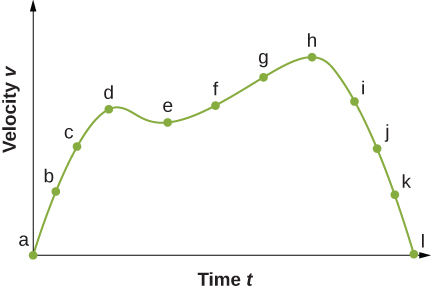
A particle has a abiding dispatch of 6.0 m/s2. (a) If its initial velocity is ii.0 m/s, at what fourth dimension is its displacement five.0 thou? (b) What is its velocity at that fourth dimension?
At t = 10 south, a particle is moving from left to right with a speed of v.0 1000/due south. At t = 20 s, the particle is moving right to left with a speed of eight.0 grand/south. Assuming the particle's acceleration is constant, determine (a) its dispatch, (b) its initial velocity, and (c) the instant when its velocity is naught.
A well-thrown ball is caught in a well-padded manus. If the acceleration of the brawl is[latex] ii.10\,×\,{ten}^{4}{\,\text{k/s}}^{two} [/latex], and one.85 ms [latex] (1\,\text{ms}={10}^{-3}\,\text{s}) [/latex] elapses from the time the ball first touches the mitt until it stops, what is the initial velocity of the ball?
A bullet in a gun is accelerated from the firing chamber to the end of the barrel at an average rate of [latex] 6.20\,×\,{10}^{5}{\,\text{m/south}}^{2} [/latex] for [latex] eight.10\,×\,{10}^{\text{−}4}\,\text{southward} [/latex]. What is its muzzle velocity (that is, its final velocity)?
Prove Solution
[latex] five=502.20\,\text{chiliad/southward} [/latex]
(a) A light-track commuter train accelerates at a rate of ane.35 m/south2. How long does it accept to reach its top speed of fourscore.0 km/h, starting from rest? (b) The same railroad train ordinarily decelerates at a rate of ane.65 m/s2. How long does it take to come up to a terminate from its summit speed? (c) In emergencies, the train tin decelerate more chop-chop, coming to rest from lxxx.0 km/h in eight.30 s. What is its emergency dispatch in meters per second squared?
While inbound a freeway, a auto accelerates from rest at a charge per unit of 2.04 one thousand/stwo for 12.0 south. (a) Draw a sketch of the situation. (b) List the knowns in this problem. (c) How far does the machine travel in those 12.0 s? To solve this function, beginning identify the unknown, then bespeak how you chose the appropriate equation to solve for it. After choosing the equation, show your steps in solving for the unknown, cheque your units, and talk over whether the respond is reasonable. (d) What is the motorcar'due south last velocity? Solve for this unknown in the same way equally in (c), showing all steps explicitly.
Unreasonable results At the end of a race, a runner decelerates from a velocity of 9.00 chiliad/southward at a rate of 2.00 m/s2. (a) How far does she travel in the adjacent 5.00 s? (b) What is her final velocity? (c) Evaluate the result. Does it brand sense?
Blood is accelerated from rest to thirty.0 cm/s in a altitude of 1.fourscore cm by the left ventricle of the heart. (a) Make a sketch of the situation. (b) List the knowns in this problem. (c) How long does the acceleration take? To solve this office, first place the unknown, and so discuss how you chose the appropriate equation to solve for it. After choosing the equation, show your steps in solving for the unknown, checking your units. (d) Is the answer reasonable when compared with the time for a heartbeat?
During a slap shot, a hockey player accelerates the puck from a velocity of 8.00 chiliad/s to xl.0 m/southward in the same direction. If this shot takes [latex] 3.33\,×\,{10}^{\text{−}2}\,\text{s} [/latex], what is the distance over which the puck accelerates?
A powerful motorcycle can advance from rest to 26.8 m/s (100 km/h) in only 3.90 s. (a) What is its average acceleration? (b) How far does it travel in that time?
Show Solution
a. six.87 southward2; b. [latex] x=52.26\,\text{m} [/latex]
Freight trains can produce only relatively small accelerations. (a) What is the concluding velocity of a freight train that accelerates at a rate of [latex] 0.0500\,{\text{thousand/s}}^{2} [/latex] for viii.00 min, starting with an initial velocity of four.00 g/s? (b) If the train can dull down at a charge per unit of [latex] 0.550\,{\text{m/s}}^{2} [/latex], how long will it take to come to a stop from this velocity? (c) How far volition it travel in each case?
A fireworks shell is accelerated from rest to a velocity of 65.0 m/s over a distance of 0.250 g. (a) Calculate the acceleration. (b) How long did the acceleration last?
A swan on a lake gets airborne by flapping its wings and running on top of the water. (a) If the swan must achieve a velocity of 6.00 thou/s to take off and it accelerates from rest at an average rate of [latex] 0.35\,{\text{m/s}}^{2} [/latex], how far will it travel before becoming airborne? (b) How long does this take?
A woodpecker's brain is specially protected from large accelerations by tendon-similar attachments inside the skull. While pecking on a tree, the woodpecker's caput comes to a stop from an initial velocity of 0.600 m/southward in a distance of just 2.00 mm. (a) Find the acceleration in meters per second squared and in multiples of yard, where 1000 = 9.80 thousand/due south2. (b) Calculate the stopping time. (c) The tendons cradling the encephalon stretch, making its stopping altitude 4.50 mm (greater than the head and, hence, less dispatch of the brain). What is the encephalon'south acceleration, expressed in multiples of 1000?
An unwary football game player collides with a padded goalpost while running at a velocity of seven.50 m/south and comes to a total stop after compressing the padding and his trunk 0.350 thousand. (a) What is his acceleration? (b) How long does the collision last?
A care package is dropped out of a cargo plane and lands in the wood. If we assume the care package speed on impact is 54 yard/due south (123 mph), so what is its acceleration? Assume the copse and snow stops information technology over a distance of iii.0 1000.
Show Solution
Knowns: [latex] 10=iii\,\text{m,}\,v=0\,\text{yard/s,}\enspace{five}_{0}=54\,\text{m/s} [/latex]. We desire a, so we can use this equation: [latex] a=\text{−}486\,{\text{m/s}}^{two} [/latex].
An express train passes through a station. Information technology enters with an initial velocity of 22.0 thousand/s and decelerates at a rate of [latex] 0.150\,{\text{m/s}}^{two} [/latex] as it goes through. The station is 210.0 yard long. (a) How fast is it going when the nose leaves the station? (b) How long is the nose of the railroad train in the station? (c) If the train is 130 m long, what is the velocity of the end of the train every bit it leaves? (d) When does the end of the train leave the station?
Unreasonable results Dragsters tin can actually accomplish a top speed of 145.0 1000/due south in only 4.45 s. (a) Calculate the average acceleration for such a dragster. (b) Find the final velocity of this dragster starting from rest and accelerating at the rate found in (a) for 402.0 m (a quarter mile) without using whatsoever information on time. (c) Why is the terminal velocity greater than that used to detect the boilerplate acceleration? (Hint: Consider whether the supposition of constant acceleration is valid for a dragster. If not, discuss whether the dispatch would be greater at the showtime or terminate of the run and what issue that would have on the final velocity.)
Glossary
- 2-body pursuit problem
- a kinematics problem in which the unknowns are calculated past solving the kinematic equations simultaneously for two moving objects
Source: https://courses.lumenlearning.com/suny-osuniversityphysics/chapter/3-4-motion-with-constant-acceleration/
0 Response to "what is a car’s acceleration if it increases its speed from 5 m/s to 20 m/s in 3 s?"
Post a Comment